This article originally appeared on the Lion’s Roar website.
SCOTT NEESON FOUND HIS HEART—AND LIFE’S TRUE RICHES—IN A PHNOM PENH GARBAGE DUMP. LINDSAY KYTE PROFILES THE FOUNDER OF THE CAMBODIAN CHILDREN’S FUND.
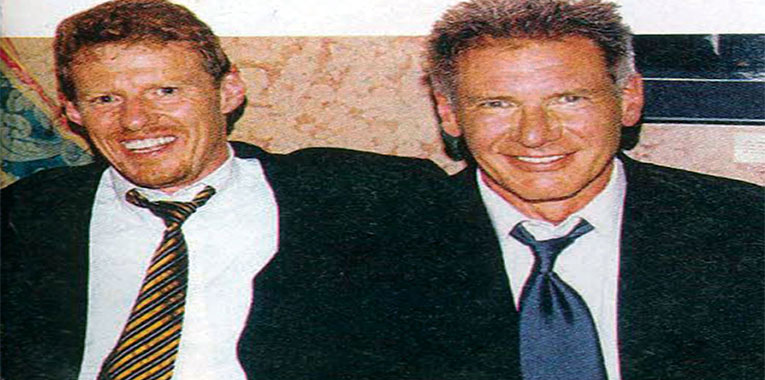
Once upon a time, Scott Neeson lived a Hollywood life. “I was president of Twentieth Century Fox International and had signed up to start a new job at Sony Pictures International,” he says. “I put in a five-week break to cleanse myself from so much time in the film business.”
Neeson had a passion for Buddhist monuments and embarked on a tour of Southeast Asia and India. But what he experienced wasnt the peaceful reprieve he had envisioned—while in Cambodia, he decided to make an unusual request.
“When I was in Phnom Penh, I asked to see the worst poverty in the country,” Neeson recalls. “They took me to Stung Meanchey, a garbage dump a hundred yards deep that covers twenty-five acres.”
Standing there changed everything for Neeson. “More than 1,500 children were scavenging among this garbage. It was over 130 degrees Fahrenheit, and at that temperature the garbage decomposes and produces methane, while the ground below is essentially lava or molten garbage. I had burns on my feet from not watching where I was stepping, and the stench was unbearable.”
Many of the children scavenging were abandoned by parents who could no longer care for them due to debt, illness, alcoholism, or remarriage. Neeson felt a strong urge to help, but says he still had the classic prejudices against charities.
“The three most common are, one, you don’t know where your money’s going,” he explains. “You always think someone’s getting a fat salary and only a few pennies actually hit the ground. The second is that as one individual, you can’t make that much of an impact. Even all your salary wouldn’t make a tangible difference. The third one is, ‘It isn’t my problem.’ Sitting in the U.S., you feel like it’s the other side of the world. You pay taxes, so it’s up to the government to provide foreign aid.”
But Neeson couldn’t ignore this call to action. “I knew there was no way for these children to ever get off this garage dump. They would live there, they would die there. They would be taken for trafficking. The mothers would give birth there. It was the apocalypse. It was horrendous.”
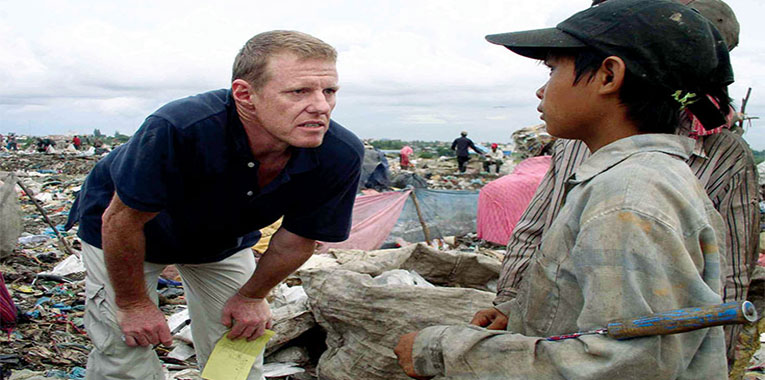
A nine-year-old walked past Neeson in a wretched state, and the sight broke his heart. “At first I couldn’t tell whether it was a boy or a girl because the child was completely swathed up—all you could see were the eyes,” he says. “Part of it was the searing heat, but, also, these were all the articles of clothing she had. There was no place to leave anything you owned.”
Through an interpreter, Neeson discovered the girl was there with her sister and mother. “Through some quick discussion and corporate problem-solving skills, we identified a place for her to live and got her into a school. I put together a system where I could send money from Los Angeles to her mother weekly. I got the youngest daughter, who was sick with typhoid, into hospital.”
AS A HUMAN BEING, AS A LIVING, BREATHING PERSON, I HAD AN OBLIGATION. I WAS HOOKED BY THE MERE FACT OF HOW EASY IT WAS TO CHANGE THE LIFE OF THAT CHILD.
Neeson was shocked that this had taken only ninety minutes and would cost him only $35 a month. “I had, as a single individual, profoundly changed the destiny of this one child,” he says. “All of my prejudices about charities went out the window right there. There was no plan B for these children. It was my problem. As a human being, as a living, breathing person, I had an obligation. I was hooked by the mere fact of how easy it was to change the life of that child.”
When Scott Neeson went back to the U.S. to start his new job, “I made a promise that I wasn’t going to have a classic Los Angeles midlife crisis,” he says. “I’d been working for twenty-six years in the film business. I had worked my way up from being a projectionist at a drive-in theater, and I wasn’t going to throw it all away.”
Yet the urge to help more children only got louder. “I couldn’t stop thinking about it,” Neeson says. “I spent the next year making monthly trips to Cambodia furthering the cause, getting more children involved, hiring staff. My idea was to have my two worlds coexist—to spend three weeks in my Hollywood film environment, where you fly first class, go to the Academy Awards, hang out with all the celebrities, make a million dollars a year or more—and then send that money to Cambodia.
“What I didn’t count on was the emotional trauma of moving between this indulgent lifestyle and then, within twenty-four hours, standing in probably the most squalid, impoverished place in the world, where children and mothers are dying in front of you for lack of simple medical care. Having those two worlds come together was something I couldn’t live with.”
Neeson’s moment of clarity came calling—literally. “There was a well-known actor I was dealing with at the time and we were on the road for publicity. I’d left for Cambodia and he was going to Tokyo. I went straight to the garbage dump. One of the grandmothers was visibly agitated and took me to four young children under the age of ten. They were dying, and no one was able to take them to hospital. The children didn’t belong to anyone. I didn’t know what to do. It was horrible.
“At that moment, my cell phone rang. It was the actor and his agent on the tarmac in Tokyo. He was quite angry because we had put the wrong amenities on his private jet. Then he calmed down for a moment and said, ‘My life just wasn’t meant to be this difficult.’
THE REST OF THE WORLD WAS TELLING ME I WAS OUT OF MY MIND, THAT I HAD THE JOB EVERYONE DREAMS OF, BUT I DIDN’T WANT IT ANYMORE.
“This is what he said to me as I was standing there with those dying children. It was the most clarifying moment, because all the anxiety I had about giving up my job to live in Cambodia, all that fear, went away. It was gone. There was no clearer signal to me that I was on the right path. It changed my entire perspective. I went back to Los Angeles and resigned the following Monday.”
Not everyone there thought it was the right choice. “The rest of the world was telling me I was out of my mind, that I had the job everyone dreams of,” Neeson says. “But I didn’t want it anymore.”
Neeson moved to Cambodia and started the Cambodian Children’s Fund (CCF) in 2004, which works with impoverished communities, centered around the former garbage dump at Steung Meanchey, to provide programs in education, leadership, community outreach, health care, child care, and vocational training.
“I sold my boat, the house, the cars. I had the mother of all garage sales,” Neeson says. His vision was to send eighty children to school. “Today we have 2,200 children studying.”
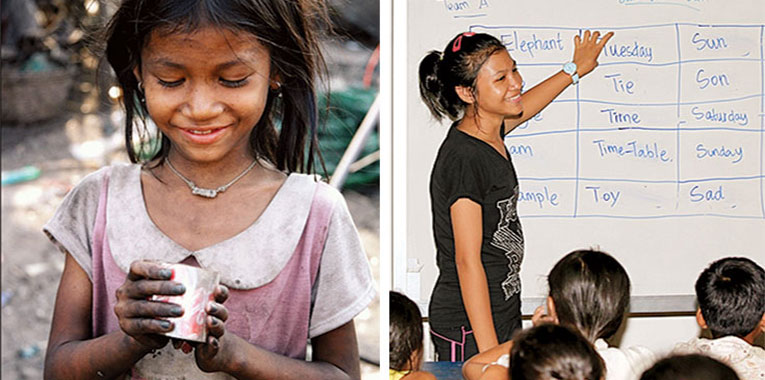
Starting to practice Buddhism was not a deliberate choice. It happened gradually as Neeson lived amid Cambodia’s Buddhist culture. “I was unconsciously becoming more Buddhist the longer I stayed,” he says. What Neeson did know from the start was that in order to create meaningful change for those around him, he had to start by examining himself.
“I loved the children dearly, and those who were not abandoned had parents who had been through the Khmer Rouge as children themselves,” Neeson explains, referencing the Communist regime between 1975 and 1979 during which an estimated one and a half to three million Cambodians died.
“Yes, these people learned some parenting skills, but there was also a lot of abuse and alcoholism,” he says. “So I had to become what I wanted them to emulate, and that meant ensuring I was unscrupulously honest in what I did and what I said.”
A large part of Neeson’s Buddhist practice involved overcoming his judgmental mind. “You’re dealing with such severe cases, and there’s a tendency in the West to judge people for their actions,” he says. “I realized I was burning myself out with judgment. It occurred to me one day that I had never walked in their shoes. I then saw that the only way to continue in any fair way was to suspend all judgment and take it on a day-by-day basis.”
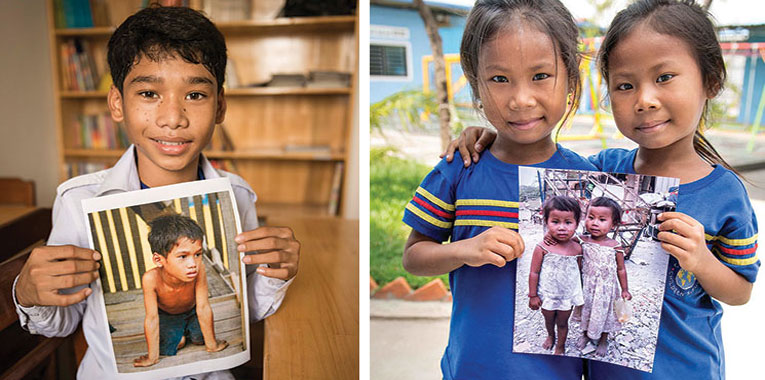
It was not an easy task. “I see some of the most horrendous abuses against children. When I get a new child, and he’s been through some terrible times, it’s like I’m looking at a beautiful broken vase or a glass. I didn’t break it, and there’s no point worrying about how it got broken. It’s a matter of being able to make it good again, to either put it back together anew or into its original form.
“We provide an education that will take the student as far as their abilities will allow,” Neeson continues. “So if they put in the hours and pass, they can go all the way through university. We will help them and support them all the way through.”
But Neeson knows that to help children effectively, you often have to help their whole family. “Even four- and five-year-olds are working because parents have debt or are sick and they have no option,” he explains. “So we work out a specific program so families see their lives improved. Then the child can have a childhood and no worries other than studying and doing the community work.
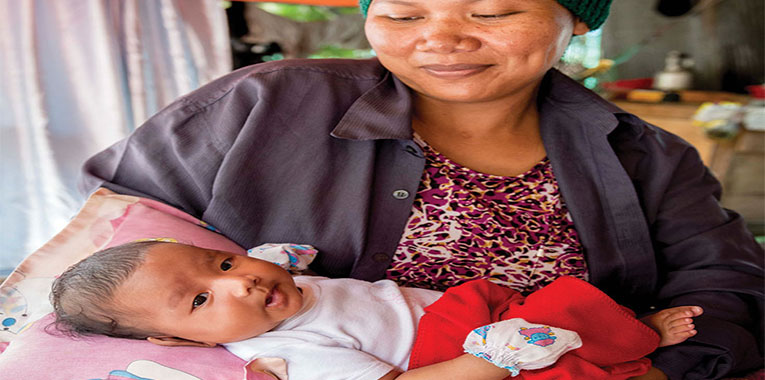
“We offer families a whole series of benefits. If a child goes to school, the parents get free health care visits at a medical clinic. We’ll deliver fresh water to the door for those who are sick.” CCF also offers refinancing for those in debt.
“A $200 debt will cost them approximately a dollar a day for the rest of their lives. There’s no way out of it. So if the parents can meet the basic values of getting the child to school and there is no violence or substance abuse, then we will refinance the loan. And once it’s paid off, we help the family start a small business or perhaps buy back the family land.”
CCF works to restore parts of Cambodia’s traditional culture that were lost because of the atrocities of the Khmer Rouge period. That wisdom is held by the society’s elders.
“I spent a lot of time with the grandmothers, those who had grown up before the Khmer Rouge, who still had memories of the old days,” Neeson says. “They’re devout Buddhists. I listened to them talk about what life was like. They had lived in awful conditions—begging, trying to find food in trash. Most had lost their children during the Khmer Rouge days.
“I was astounded by their resilience and their ability to overcome what had been done to them. There was not the resentment or bitterness you would expect, given what they had been through. They were so loving, and they still are.”
Out of his own pocket, Neeson started giving the grandmothers money and rice each week. Then he decided to make sure their wisdom was passed on to the younger generations. He developed a community youth leadership program, designed to give thirteen- to seventeen-year-olds a sense of responsibility, the ability to speak in public, and a voice to speak up for their rights.
“It was also designed to teach empathy, which is sadly lacking here,” says Neeson. “Empathy tends to be one of the first casualties of poverty.” Youth are paired up with grandmothers, and are responsible for checking on them, getting them rice and medication and other things they need. This also encourages interaction between generations to help youth learn traditional values of Buddhism, family, and Cambodian culture.
Maternal care is another a priority for CCF. “Last week, we had the one-thousandth birth and we have maintained a zero maternal death rate,” Neeson says. “It used to be about 6 or 7 percent on the garbage dump. We’ve never lost a mother.”
The maternal care program includes blood tests, bringing in grandmothers to teach mothers about prenatal and postnatal care, and giving community youth the responsibility to report domestic violence. CCF pays for hospital stays for giving birth, and the mother receives a “Welcome Home Baby Pack”—gloves, a hat, a washable mat, disinfectant, antiseptic, a mosquito net, and more.
“As well as being practical, it gives the mother a sense of pride,” says Neeson. “Normally a child would be something of a burden, possibly putting the family into debt. These days, when we have the postnatal training session, they’re all showing each other the babies proudly. I do all my oohs and ahs and take photographs. I have 165,000 photos on my computer.”
I’VE NEVER HAD SO LITTLE AND SO MUCH AT THE SAME TIME. STRANGELY, THERE’S NOTHING I NEED. IT’S SUCH A WONDERFUL FEELING, AND ABSOLUTE FREEDOM.
Thanks to CCF, in the Steung Meanchey area of 12,000 people, most children now spend their days in the classroom, with a low absentee rate due to the benefits parents receive for keeping their children in school. CCF has built 400 homes for families with a long-term commitment to keeping their children in school. “We’re putting together these communities of good people and it radiates outward,” Neeson says. “When you’ve got a community of fifteen homes where people have common values, people outside the community see what’s possible.
“We’re not imposing our own values. We don’t want abstinence from alcohol. We just don’t want them getting drunk every night. If your child has a perfect attendance record, we pay for the family’s rice for the month. It’s considered a benefit, but it’s basic human rights. People deserve fresh water, enough food on the table, and the ability to access medical care.”
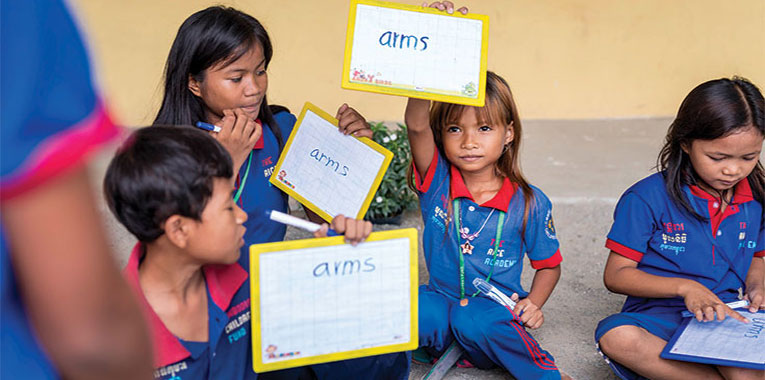
“I’ve never had so little and so much at the same time,” Neeson says. “I have virtually nothing in the way of material possessions. Strangely, there’s nothing I need. It’s such a wonderful feeling. It gives you absolute freedom. You’re not beholden to other people’s dreams and the desire for more material things.”
Neeson had a dream of expanding the CCF model to other locations, but his heart and energy are rooted firmly in this community. “I just can’t leave the kids and the families and the grandmothers,” he says. CCF has now been active for twelve years.
And the nine-year-old girl who walked by him that first day he stood on the garbage dump? “She is about to start her third year of a university degree in finance and management. She’s the pride and joy,” Neeson says. “Eighty percent of the original children are now in university.”
Neeson says he found real love in the garbage dumps of Cambodia. “I’d never had any kind of deep love,” he says. “I’d had a number of shorter-term relationships. I was highly eligible in the Hollywood community. It was a great life. People ask me if I miss anything about that. Absolutely. It’s very alluring to never want for money, to have the best of medical care, and a Porsche and a yacht in Marina del Rey, and a police department if anything goes wrong, or a hospital nearby. Occasionally, I have these pangs where I miss that and I just want to relax and live the good life.
“But, my goodness, overall I wouldn’t change anything. I still ask myself, ‘What if I hadn’t gone here? What if I hadn’t discovered this place and hadn’t had the opportunity to change so many lives?’
Neeson had put just everything in perspective the morning I talked to him.
“I was writing a card to one of the kids today,” he told me, “and I said I would have left Hollywood, given it all up, just for her alone. And I meant it. There are so many children whose lives have changed so much. They’re studying law, psychology, civil engineering, and they’re the most amazing young adults. It’s such a blessing for me.
“I can’t tell you how fortunate I’ve been. Some people will go their whole lives without ever having that moment of awakening that happened to me when I first saw the children that day in the Stung Meanchey garbage dump. I am lucky.”

Leave a Reply